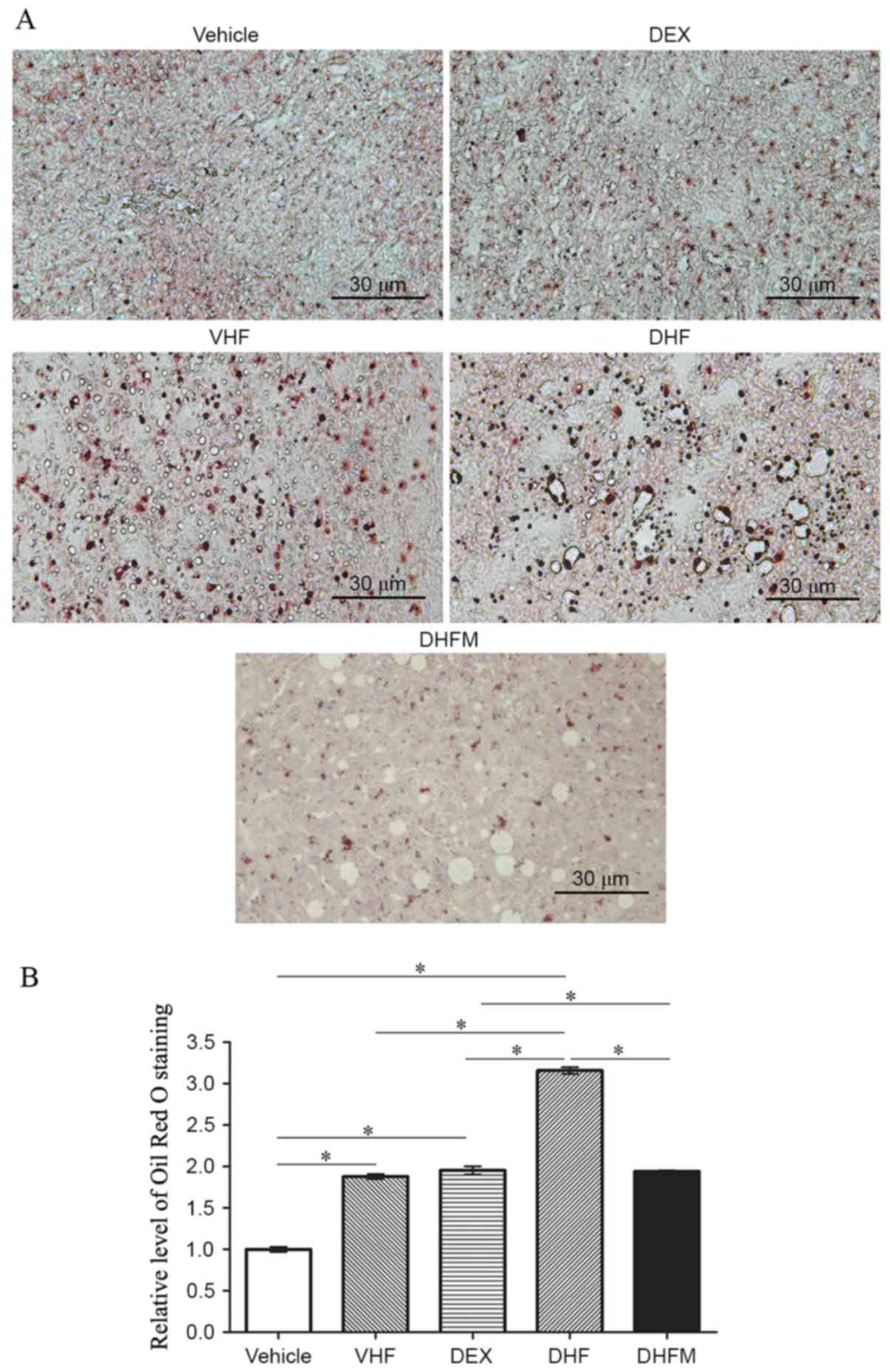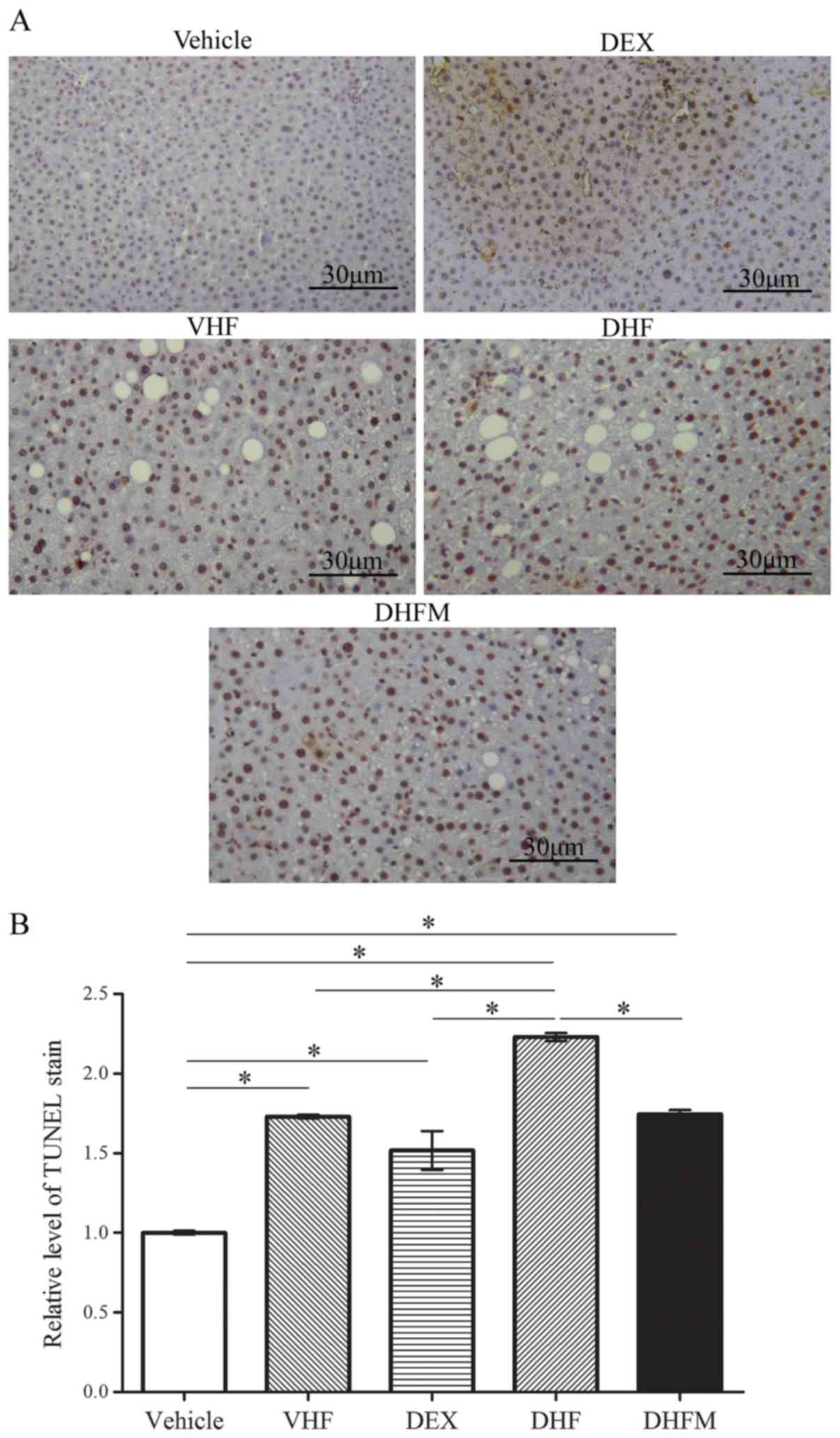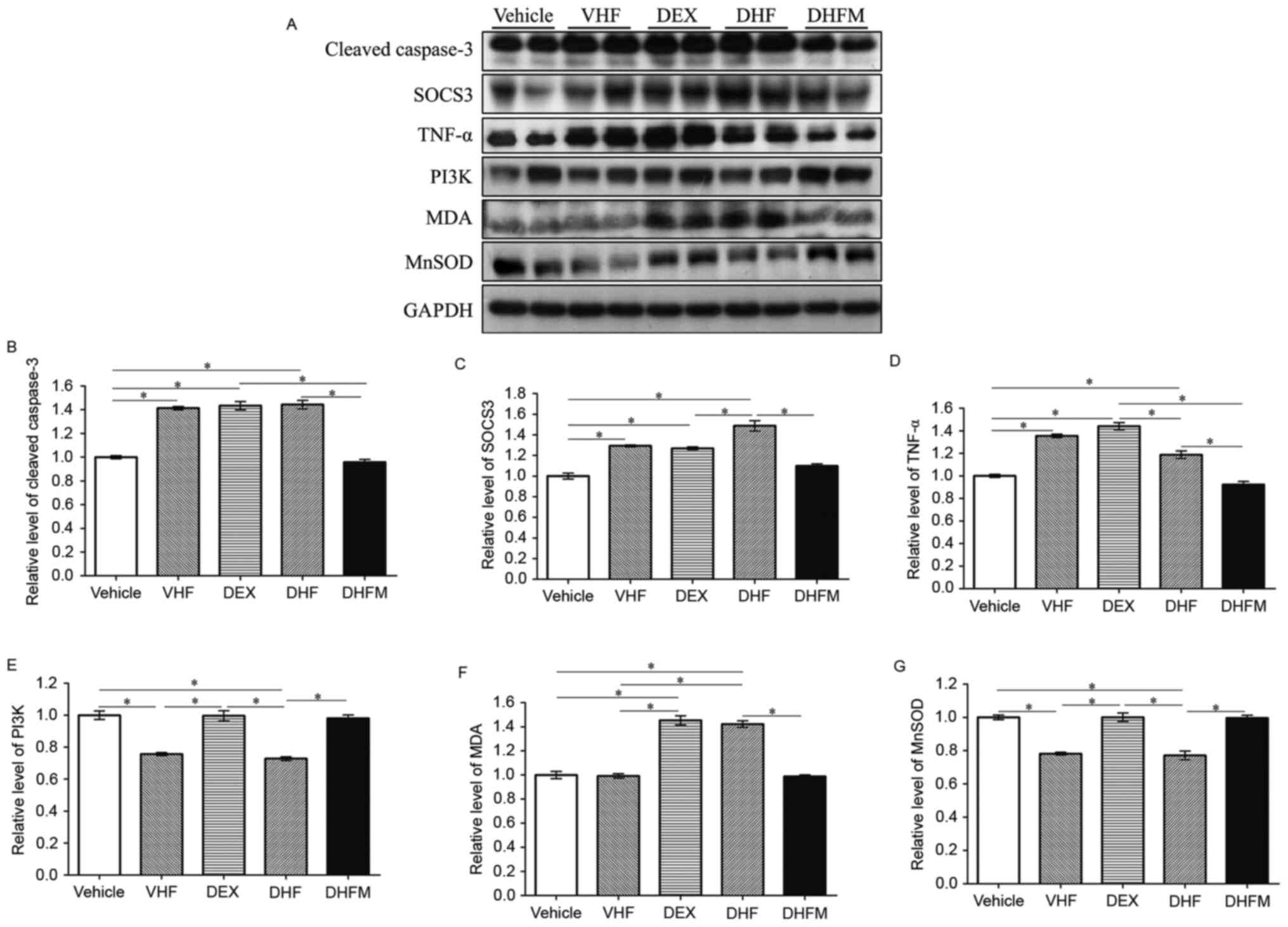|
1
|
Malik VS, Willett WC and Hu FB: Global
obesity: Trends, risk factors and policy implications. Nat Rev
Endocrinol. 9:13–27. 2013. View Article : Google Scholar : PubMed/NCBI
|
|
2
|
Cohen JC, Horton JD and Hobbs HH: Human
fatty liver disease: Old questions and new insights. Science.
332:1519–1523. 2011. View Article : Google Scholar : PubMed/NCBI
|
|
3
|
Stacchiotti A, Favero G, Lavazza A, Golic
I, Aleksic M, Korac A, Rodella LF and Rezzani R: Hepatic
macrosteatosis is partially converted to microsteatosis by
melatonin supplementation in ob/ob mice non-alcoholic fatty liver
disease. PLoS One. 11:e01481152016. View Article : Google Scholar : PubMed/NCBI
|
|
4
|
Kapoor A, Petropoulos S and Matthews SG:
Fetal programming of hypothalamic-pituitary-adrenal (HPA) axis
function and behavior by synthetic glucocorticoids. Brain Res Rev.
57:586–595. 2008. View Article : Google Scholar : PubMed/NCBI
|
|
5
|
Varcoe TJ, Boden MJ, Voultsios A, Salkeld
MD, Rattanatray L and Kennaway DJ: Characterisation of the maternal
response to chronic phase shifts during gestation in the rat:
Implications for fetal metabolic programming. PLoS One.
8:e538002013. View Article : Google Scholar : PubMed/NCBI
|
|
6
|
Tiao MM, Huang LT, Chen CJ, Sheen JM, Tain
YL, Chen CC, Kuo HC, Huang YH, Tang KS, Chu EW and Yu HR: Melatonin
in the regulation of liver steatosis following prenatal
glucocorticoid exposure. Biomed Res Int. 2014:9421722014.
View Article : Google Scholar : PubMed/NCBI
|
|
7
|
Drake AJ, Raubenheimer PJ, Kerrigan D,
McInnes KJ, Seckl JR and Walker BR: Prenatal dexamethasone programs
expression of genes in liver and adipose tissue and increased
hepatic lipid accumulation but not obesity on a high-fat diet.
Endocrinology. 151:1581–1587. 2010. View Article : Google Scholar : PubMed/NCBI
|
|
8
|
Tamashiro KL, Terrillion CE, Hyun J,
Koenig JI and Moran TH: Prenatal stress or high-fat diet increases
susceptibility to diet-induced obesity in rat offspring. Diabetes.
58:1116–1125. 2009. View Article : Google Scholar : PubMed/NCBI
|
|
9
|
Huang YH, Chen CJ, Tang KS, Sheen JM, Tiao
MM, Tain YL, Chen CC, Chu EW, Li SW, Yu HR and Huang LT: Postnatal
high-fat diet increases liver steatosis and apoptosis threatened by
prenatal dexamethasone through the oxidative effect. Int J Mol Sci.
17:3692016. View Article : Google Scholar : PubMed/NCBI
|
|
10
|
Favero G, Lonati C, Giugno L, Castrezzati
S, Rodella LF and Rezzani R: Obesity-related dysfunction of the
aorta and prevention by melatonin treatment in ob/ob mice. Acta
Histochem. 115:783–788. 2013. View Article : Google Scholar : PubMed/NCBI
|
|
11
|
Govender J, Loos B, Marais E and
Engelbrecht AM: Mitochondrial catastrophe during
doxorubicin-induced cardiotoxicity: A review of the protective role
of melatonin. J Pineal Res. 57:367–380. 2014. View Article : Google Scholar : PubMed/NCBI
|
|
12
|
Tan DX, Manchester LC, Fuentes-Broto L,
Paredes SD and Reiter RJ: Significance and application of melatonin
in the regulation of brown adipose tissue metabolism: Relation to
human obesity. Obes Rev. 12:167–188. 2011. View Article : Google Scholar : PubMed/NCBI
|
|
13
|
Hussein MR, Ahmed OG, Hassan AF and Ahmed
MA: Intake of melatonin is associated with amelioration of
physiological changes, both metabolic and morphological pathologies
associated with obesity: An animal model. Int J Exp Pathol.
88:19–29. 2007. View Article : Google Scholar : PubMed/NCBI
|
|
14
|
Kitagawa A, Ohta Y and Ohashi K: Melatonin
improves metabolic syndrome induced by high fructose intake in
rats. J Pineal Res. 52:403–413. 2012. View Article : Google Scholar : PubMed/NCBI
|
|
15
|
García JJ, López-Pingarrón L,
Almeida-Souza P, Tres A, Escudero P, García-Gil FA, Tan DX, Reiter
RJ, Ramírez JM and Bernal-Pérez M: Protective effects of melatonin
in reducing oxidative stress and in preserving the fluidity of
biological membranes: A review. J Pineal Res. 56:225–237. 2014.
View Article : Google Scholar : PubMed/NCBI
|
|
16
|
de Luxán-Delgado B, Caballero B, Potes Y,
Rubio-González A, Rodríguez I, Gutiérrez-Rodríguez J, Solano JJ and
Coto-Montes A: Melatonin administration decreases adipogenesis in
the liver of ob/ob mice through autophagy modulation. J Pineal Res.
56:126–133. 2014. View Article : Google Scholar : PubMed/NCBI
|
|
17
|
Celinski K, Konturek PC, Slomka M,
Cichoz-Lach H, Brzozowski T, Konturek SJ and Korolczuk A: Effects
of treatment with melatonin and tryptophan on liver enzymes,
parameters of fat metabolism and plasma levels of cytokines in
patients with non-alcoholic fatty liver disease-14 months follow
up. J Physiol Pharmacol. 65:75–82. 2014.PubMed/NCBI
|
|
18
|
Hatzis G, Ziakas P, Kavantzas N,
Triantafyllou A, Sigalas P, Andreadou I, Ioannidis K, Chatzis S,
Filis K, Papalampros A and Sigala F: Melatonin attenuates high fat
diet-induced fatty liver disease in rats. World J Hepatol.
5:160–169. 2013. View Article : Google Scholar : PubMed/NCBI
|
|
19
|
Zaitone S, Hassan N, El-Orabi N and
El-Awady el-S: Pentoxifylline and melatonin in combination with
pioglitazone ameliorate experimental non-alcoholic fatty liver
disease. Eur J Pharmacol. 662:70–77. 2011. View Article : Google Scholar : PubMed/NCBI
|
|
20
|
National Research Council: Guide for the
Care and Use of Laboratory Animals. 8th edition. National Acadamies
Press; Washington, DC; 2011, PubMed/NCBI
|
|
21
|
Hauser J, Feldon J and Pryce CR: Direct
and dam-mediated effects of prenatal dexamethasone on emotionality,
cognition and HPA axis in adult Wistar rats. Horm Behav.
56:364–375. 2009. View Article : Google Scholar : PubMed/NCBI
|
|
22
|
Lui CC, Hsu MH, Kuo HC, Chen CC, Sheen JM,
Yu HR, Tiao MM, Tain YL, Chang KA and Huang LT: Effects of
melatonin on prenatal dexamethasone-induced epigenetic alterations
in hippocampal morphology and reelin and glutamic acid
decarboxylase 67 levels. Dev Neurosci. 37:105–114. 2015. View Article : Google Scholar : PubMed/NCBI
|
|
23
|
Tain YL, Huang LT, Lin IC, Lau YT and Lin
CY: Melatonin prevents hypertension and increased asymmetric
dimethylarginine in young spontaneous hypertensive rats. J Pineal
Res. 49:390–398. 2010. View Article : Google Scholar : PubMed/NCBI
|
|
24
|
Lin TK, Huang LT, Huang YH, Tiao MM, Tang
KS and Liou CW: The effect of the red wine polyphenol resveratrol
on a rat model of biliary obstructed cholestasis: Involvement of
anti-apoptotic signalling, mitochondrial biogenesis and the
induction of autophagy. Apoptosis. 17:871–879. 2012. View Article : Google Scholar : PubMed/NCBI
|
|
25
|
Tiao MM, Wang FS, Huang LT, Chuang JH, Kuo
HC, Yang YL and Huang YH: MicroRNA-29a protects against acute liver
injury in a mouse model of obstructive jaundice via inhibition of
the extrinsic apoptosis pathway. Apoptosis. 19:30–41. 2014.
View Article : Google Scholar : PubMed/NCBI
|
|
26
|
Tiao MM, Lin TK, Kuo FY, Huang CC, Du YY,
Chen CL and Chuang JH: Early stage of biliary atresia is associated
with significant changes in 8-hydroxydeoxyguanosine and
mitochondrial copy number. J Pediatr Gastroenterol Nutr.
45:329–334. 2007. View Article : Google Scholar : PubMed/NCBI
|
|
27
|
Nieto-Vazquez I, Fernández-Veledo S,
Krämer DK, Vila-Bedmar R, Garcia-Guerra L and Lorenzo M: Insulin
resistance associated to obesity: The link TNF-alpha. Arch Physiol
Biochem. 114:183–194. 2008. View Article : Google Scholar : PubMed/NCBI
|
|
28
|
Kwon H and Pessin JE: Adipokines mediate
inflammation and insulin resistance. Front Endocrinol (Lausanne).
4:712013.PubMed/NCBI
|
|
29
|
D'Souza K, Kane DA, Touaibia M, Kershaw
EE, Pulinilkunnil T and Kienesberger PC: Autotaxin is regulated by
glucose and insulin in adipocytes. Endocrinology. 158:791–803.
2017. View Article : Google Scholar : PubMed/NCBI
|
|
30
|
Rashid K, Das J and Sil PC: Taurine
ameliorate alloxan induced oxidative stress and intrinsic apoptotic
pathway in the hepatic tissue of diabetic rats. Food Chem Toxicol.
51:317–329. 2013. View Article : Google Scholar : PubMed/NCBI
|
|
31
|
Zhang Y and Yang JH: Activation of the
PI3K/Akt pathway by oxidative stress mediates high glucose-induced
increase of adipogenic differentiation in primary rat osteoblasts.
J Cell Biochem. 114:2595–2602. 2013. View Article : Google Scholar : PubMed/NCBI
|
|
32
|
Davey MW, Stals E, Panis B, Keulemans J
and Swennen RL: High-throughput determination of malondialdehyde in
plant tissues. Anal Biochem. 347:201–207. 2005. View Article : Google Scholar : PubMed/NCBI
|
|
33
|
Del Rio D, Stewart AJ and Pellegrini N: A
review of recent studies on malondialdehyde as toxic molecule and
biological marker of oxidative stress. Nutr Metab Cardiovasc Dis.
15:316–328. 2005. View Article : Google Scholar : PubMed/NCBI
|
|
34
|
Candas D and Li JJ: MnSOD in oxidative
stress response-potential regulation via mitochondrial protein
influx. Antioxid Redox Signal. 20:1599–1617. 2014. View Article : Google Scholar : PubMed/NCBI
|
|
35
|
Diehl AM: Nonalcoholic steatosis and
steatohepatitis IV. Nonalcoholic fatty liver disease abnormalities
in macrophage function and cytokines. Am J Physiol Gastrointest
Liver Physiol. 282:G1–G5. 2002. View Article : Google Scholar : PubMed/NCBI
|
|
36
|
Tacke F, Luedde T and Trautwein C:
Inflammatory pathways in liver homeostasis and liver injury. Clin
Rev Allergy Immunol. 36:4–12. 2009. View Article : Google Scholar : PubMed/NCBI
|
|
37
|
Canbakan B, Senturk H, Canbakan M, Toptas
T, Tabak O, Balci H, Olgac V and Ozbay G: Is alanine
aminotransferase level a surrogate biomarker of hepatic apoptosis
in nonalcoholic fatty liver disease? Biomark Med. 4:205–214. 2010.
View Article : Google Scholar : PubMed/NCBI
|
|
38
|
Guha M, Maity P, Choubey V, Mitra K,
Reiter RJ and Bandyopadhyay U: Melatonin inhibits free
radical-mediated mitochondrial-dependent hepatocyte apoptosis and
liver damage induced during malarial infection. J Pineal Res.
43:372–381. 2007. View Article : Google Scholar : PubMed/NCBI
|
|
39
|
Cruz A, Padillo FJ, Torres E, Navarrete
CM, Muñoz-Castañeda JR, Caballero FJ, Briceño J, Marchal T, Túnez
I, Montilla P, et al: Melatonin prevents experimental liver
cirrhosis induced by thioacetamide in rats. J Pineal Res.
39:143–150. 2005. View Article : Google Scholar : PubMed/NCBI
|
|
40
|
Padillo FJ, Cruz A, Navarrete C, Bujalance
I, Briceño J, Gallardo JI, Marchal T, Caballero R, Túnez I, Muntané
J, et al: Melatonin prevents oxidative stress and hepatocyte cell
death induced by experimental cholestasis. Free Radic Res.
38:697–704. 2004. View Article : Google Scholar : PubMed/NCBI
|
|
41
|
Heeba GH and Morsy MA: Fucoidan
ameliorates steatohepatitis and insulin resistance by suppressing
oxidative stress and inflammatory cytokines in experimental
non-alcoholic fatty liver disease. Environ Toxicol Pharmacol.
40:907–914. 2015. View Article : Google Scholar : PubMed/NCBI
|
|
42
|
Liu Y, Song A, Zang S, Wang C, Song G, Li
X, Zhu Y, Yu X, Li L, Wang Y and Duan L: Jinlida reduces insulin
resistance and ameliorates liver oxidative stress in high-fat fed
rats. J Ethnopharmacol. 162:244–252. 2015. View Article : Google Scholar : PubMed/NCBI
|
|
43
|
Jiang Y, Chen L, Wang H, Narisi B and Chen
B: Li-Gan-Shi-Liu-Ba-Wei-San improves non-alcoholic fatty liver
disease through enhancing lipid oxidation and alleviating oxidation
stress. J Ethnopharmacol. 176:499–507. 2015. View Article : Google Scholar : PubMed/NCBI
|
|
44
|
Jorgensen SB, O'Neill HM, Sylow L,
Honeyman J, Hewitt KA, Palanivel R, Fullerton MD, Öberg L,
Balendran A, Galic S, et al: Deletion of skeletal muscle SOCS3
prevents insulin resistance in obesity. Diabetes. 62:56–64. 2013.
View Article : Google Scholar : PubMed/NCBI
|
|
45
|
Yang G, Badeanlou L, Bielawski J, Roberts
AJ, Hannun YA and Samad F: Central role of ceramide biosynthesis in
body weight regulation, energy metabolism, and the metabolic
syndrome. Am J Physiol Endocrinol Metab. 297:E211–E224. 2009.
View Article : Google Scholar : PubMed/NCBI
|
|
46
|
Shi H, Cave B, Inouye K, Bjørbaek C and
Flier JS: Overexpression of suppressor of cytokine signaling 3 in
adipose tissue causes local but not systemic insulin resistance.
Diabetes. 55:699–707. 2006. View Article : Google Scholar : PubMed/NCBI
|
|
47
|
Buzzelli MD, Navaratnarajah M, Ahmed T,
Nagarajan M, Shumate ML, Lang CH and Cooney RN: Nuclear factor
kappaB mediates the inhibitory effects of interleukin-1 on growth
hormone-inducible gene expression. J Trauma. 64:1427–1436. 2008.
View Article : Google Scholar : PubMed/NCBI
|
|
48
|
Torisu T, Sato N, Yoshiga D, Kobayashi T,
Yoshioka T, Mori H, Iida M and Yoshimura A: The dual function of
hepatic SOCS3 in insulin resistance in vivo. Genes Cells.
12:143–154. 2007. View Article : Google Scholar : PubMed/NCBI
|












